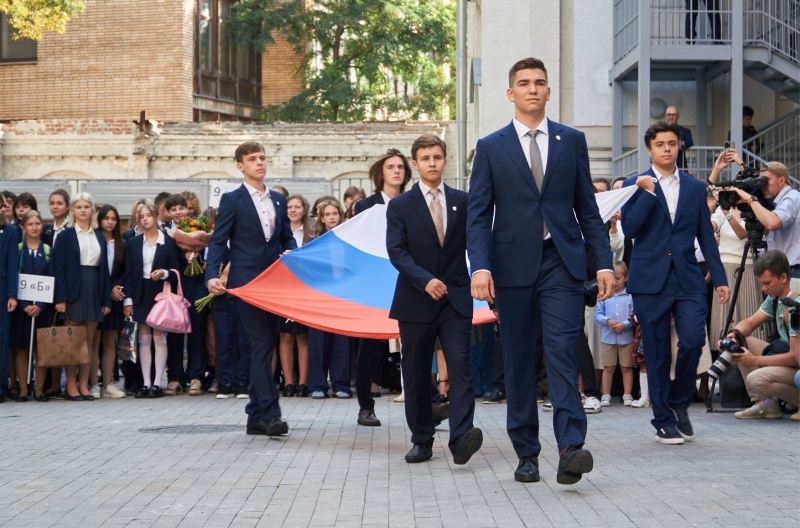On Sept. 1, Russian kindergartens introduced a new course called “Conversations About Important Things,” around ten percent of which will focus directly on the war in Ukraine and other military themes. Since 2022, the role teachers are expected to play in the political education of their students has increased dramatically. Until now, however, ideological indoctrination had been limited to schools and universities. Countless manuals instruct Russian teachers to monitor their students’ social media behavior, casual conversations, and overall appearance — and to report any concerns to the security services so that the authorities can carry out “preventive” work. From universities and schools all the way down to kindergartens, young Russians are being taught to accept the validity of Putin’s “special military operation,” to “respond correctly” to dissent, and to report any suspicious behavior to the proper adults.
“A new student joins your class — Stas. He likes to talk about politics and discuss what’s happening in society. He’s persuasive, considers himself part of the opposition, and thinks it’s cool to challenge public opinion. One day, Stas invites several classmates to join an unauthorized rally, promising it will be fun and exciting. He even says there’s a cash reward for taking part. Your friends ask you to come along. What decision will you make, and why?”
This is the script of one of the propaganda videos shown to students in Russian schools, colleges, and universities. The animated film presents only one “correct” response: to report the opposition-minded classmate to the police.
With the start of the war in Ukraine, Russian educational institutions began receiving hundreds of propaganda manuals from the authorities, says Pavel Talankin, a former social educator at a school in the Chelyabinsk region and co-author of the film Mr. Nobody vs. Putin, which explores the militarization of Russian education.
“The documents came down to us from all sorts of organizations — not just the Education and Enlightenment Ministries, but also the Distance Learning System, the Ministry of Social Relations, and [state youth development watchdog] Rosmolodezh,” Talankin recalls. “About 50 manuals a month. If some agency urgently needed to stage a patriotic event to meet its reporting quota, they made us organize it.”
According to the teacher, his school was one of the “lucky” few where new propaganda techniques were “tested.” Political lessons appeared there even before the nationwide rollout of “Conversations About Important Things.”
Schoolchildren are indeed vulnerable to propaganda, Talankin believes. He recalls a lesson for fourth graders titled “Hero of Today,” which he observed. A special manual had even been developed for the topic. At first, the teacher talked about people who help the elderly cross the street or love animals, but then abruptly switched to speaking about Putin — about his respect for nature and the older generation. At the end of the class, students were asked whom they considered a hero of Russia, and most named the president.
As Talankin notes, manuals on working with young people are developed not only by the federal Ministry of Education but also by numerous regional and municipal departments and their subordinate agencies. Yet all of them follow the narratives coming out of the Kremlin. As the official rhetoric shifts, so do the definitions of extremism, terrorism, and “destructive” or “radical” movements outlined in these documents.
The “Comprehensive Plan to Counter the Ideology of Terrorism,” drafted back in 2013 by the FSB-controlled National Antiterrorism Committee controlled, required that schools conduct “prevention of extremist ideology” among young people. At the time, that mainly referred to radical Islam. Over the years, however, the definition has expanded significantly.
As of 2024, the “ideology of terrorism” includes “radical pseudo-Islam,” “Ukrainian nationalism and neo-Nazism,” “mass-murder subcultures,” and other ideas allegedly promoted by “organizations designated as terrorist.” The plan also recommended preventive work among teenagers who previously lived in territories “controlled by the Kyiv regime,” as well as among migrants.
In 2023, following the adoption of laws targeting the LGBTQ community, a manual published by the Federal Institute for Education Quality Assessment (FIOKO) slapped a “destructive youth behavior” classification on such phenomena as “abnormal sexual urges and perversions,” “distorted gender-role identification,” “professional begging,” “shocking body modifications,” “freak style,” and membership in “marginal subcultures.”
A 2022 manual on “preventing involvement in destructive subcultures,” issued by the Saratov Law Academy, simultaneously listed as “radicals” the groups Male State, RadFem, Antifa, hippies, and skinheads. It described the childfree movement as a “potentially destructive subculture,” while labeling TikTokers, anime fans, anti-vaxxers, and “Slavic neo-pagans” as “destructively passive.”
Recommendations for identifying “adherents of radical ideologies” among university students, published in 2023, claimed that Russian youth were being recruited by the Ukrainian Azov regiment and the Freedom of Russia legion. The list of radicals again included anarchists and neo-Trotskyists but was expanded to encompass “ultra-radical feminists” and, unexpectedly, “supporters of radical patriarchy.”
Radical ideologies, according to official definitions, include anarchism and neo-Trotskyism, as well as “ultra-radical feminism” and “support of radical patriarchy”
Another manual, issued in 2024, describes the activities of “foreign agents” and “undesirable organizations” as a threat. Its authors claim that the Feminist Anti-War Resistance carries out sabotage operations, collects donations for the Ukrainian Armed Forces, and passes intelligence on Russian troop movements to Ukraine.
The same document lists the “International LGBT Public Movement,” the youth group Vesna, and organizations linked to the late Alexei Navalny (the Anti-Corruption Foundation, the Citizens’ Rights Protection Foundation, and Navalny’s various regional headquarters). According to the authors, these groups spread disinformation about the actions of Russian troops, call for funding the Ukrainian army, encourage acts of sabotage, and ultimately seek to overthrow the Russian government.
Propaganda through ‘educational’ videos
In addition to manuals, educational institutions produce a vast amount of video content. One such clip, Don’t Give In to Destructiveness, created by the Anti-Terrorism Commission of Saransk, urges students to report “any oddities or threats” to parents and teachers. It warns them against joining “powerful brotherhood-type organizations that promise protection” or youth movements that “exploit the need for individuality, self-expression, and independence.” The leaders of such groups are portrayed as “resentful people who want teenagers to commit suicide.” The video’s slogan reads: “Remember: keeping silent means getting into trouble.”
Students are warned against joining “powerful brotherhood-type organizations that promise protection”
One of the most common ways to intimidate young people in Russia today is through warnings about liability for “extremism.” An example of this approach is the animated film Justifying Terrorism (The Right Choice), produced by the Chelyabinsk Research Center for Monitoring and Prevention (NITsMP). In the cartoon, the main character discovers a social media community that posts about injustice in the world and the need to “take up arms to change the state system so that everyone can live well.” A voice-over narrates: “Dasha liked the posts claiming that only through violence and terror can prosperity be achieved, and she decided to repost them.”
The film then introduces the article of the Criminal Code on “public justification of terrorism,” showing the heroine crying in prison. The narrator warns that this law applies even to people under the age of 16. The lesson concludes that Dasha should have reported the community instead of sharing its posts.
Another video produced by NITsMP advises students not to associate with older classmates who present themselves as nationalists, “wear similar clothes with patches,” dislike migrants, and recruit others to be “patriots of their homeland.” Xenophobia is also addressed in a dramatized video by a Chelyabinsk organization devoted to “political extremism.” The issue is illustrated through offensive remarks directed at a Black student: “They’ve come here, taken our state-funded spots, and can’t even speak Russian. Russia for Russians!” The video concludes that the proper response to such incidents is to file a complaint.
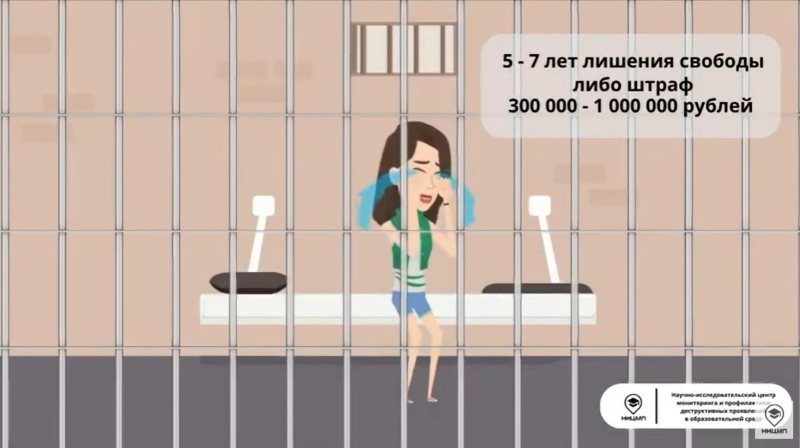
Although many “anti-extremist” manuals mention xenophobia, educational institutions rarely address it in practice, says educator Dima Zitzer: “It’s a deception, because a huge number of children are denied admission to school simply for not speaking Russian well — supposedly as part of ‘preventing interethnic conflict.’” Pavel Talankin agrees that the topic is avoided in schools: “I remember only one event promoting tolerance toward all nationalities — and that was back in 2013 or 2014. Since then, I can’t recall hearing that word even once.”
Russian propaganda pays special attention to young people living in the occupied territories of Ukraine. The authors of Rosmolodezh manuals admit that, because of the “situation in the regions of the special military operation,” children and young people are unable to “meet their basic needs due to disruptions in education, the loss of parents and loved ones, and a lack of essential resources and money.” However, instead of addressing these problems, the proposed solution is more propaganda.
Teachers are advised to tell children that the Ukrainian people have “become victims of their own government” and “cannon fodder,” while “external forces” do not wish the peoples of Russia well. The authors warn educators that if they fail to “fill the gaps” in young people’s knowledge, “opponents” will do so — which is why propaganda activities must be carried out.
Teachers are instructed to convey that the Ukrainian people have “become victims of their own government” and “cannon fodder”
A separate section of the manual is devoted to “risk groups” prone to involvement in illegal activities. The text notes that this information is intended for youth policy specialists and “not for public distribution” — although the manual is freely available on the websites of many educational institutions and government agencies.
The “risk groups” include supporters of far-right ideologies (which can be identified by recognizing relevant symbols on social media), students “influenced by anti-Russian propaganda,” “critics of the special military operation,” adherents of the “Columbine ideology,” and anarchists. Educators are advised to detect “potential threats” by monitoring students’ posts and subscriptions on social media, as well by looking out for specific “marker words” such as “Putler,” “special shit operation,” “Kremlin dwarf,” or “Rashka.”
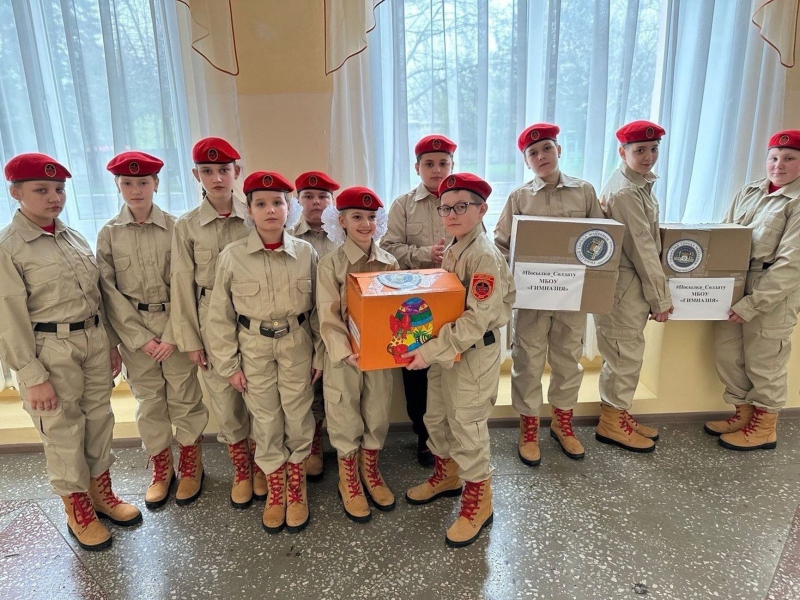
A Ukrainian teenager may fall under suspicion of sympathizing with the “Columbine ideology” simply for posting pictures of weapons, while the manual suggests labeling someone an anarchist merely for sharing an image of a black cat or a pirate flag with a skull and crossbones.
Manuals require teachers to carry out “monitoring of those exposed to extremist structures,” both among students and colleagues. In the case of children, this means checking their social media, looking for banned symbols, and identifying other signs of dissent.
One manual lists the following as indicators of “extremist influence”: having multiple accounts on the same social network, using the names of subculture or youth movement leaders instead of their own, and displaying specific symbols — emojis, hieroglyphs, or Arabic script. Other potential warning signs include using profile pictures featuring a signa (a sheet of paper with a name), images of anime characters, or “depressive aesthetics.” Even a blank profile page, a small number of friends, or having no friends at all can raise suspicion.
Suspicion can also be raised by a teenager’s blank social media profile or lack of online friends
Other warning signs listed in such manuals include “demonstrating the use of psychoactive substances and risk-taking behavior,” “an unhealthy preoccupation with death” (images of cemeteries or coffins), pharmacology-related terms, subscriptions to communities connected with eating disorders, heightened interest in weapons, “excessive obsession with manga comics,” imitating video game characters, subscriptions and comments in politically themed groups, and a lack of “age-appropriate hobbies.”
Since 2022, educational institutions have posted on their websites a “Procedure for Monitoring Students’ Social Media.” The purpose of this monitoring is to identify minors who are involved in “destructive communities.” Each “offense” is assigned points, which are recorded in a special table as a direct or indirect indicator of “destructive behavior.” Even if no risks are detected, the information gathered is still entered into the database, and the procedure is repeated after two months to track changes over time. Teachers are required to monitor students’ use of social media platforms, including Likee, VK, and TikTok.
According to another protocol, a teacher must immediately report to the deputy principal for student affairs if they notice anything unusual about a child. But of course, tracking all of their students’ accounts is technically impossible, explains social studies teacher Roman Ivanov:
“How are teachers supposed to find the real accounts of their students? Suppose teenagers create a group or pages specifically for the school to see and post harmless content like pictures of cats, while also running a private chat or community under pseudonyms where they post completely different things.”
Students are monitored not only on social media but also within schools. Manuals outline several techniques for such observation: personal interviews, recording students’ radical statements during lessons, keeping regular diary notes on behavioral trends, and maintaining a “teacher observation map.” In addition to their sentiments regarding the war in Ukraine, teachers are expected to assess students’ knowledge of anti-terrorism legislation and their attitudes toward “traditional values.”
There are specific guidelines for teachers on how to respond to “unreliable” students: make note of the content of any pro-opposition statements, gauge the reaction of the class, and check whether the “oppositionist” displays any symbols of the Russian Volunteer Corps, the Freedom of Russia legion, or other organizations designated as terrorist by the Russian authorities.
Teachers are instructed to remain calm and prevent the “lesson from turning into a political action.” According to the manual, the teacher must record the statement, its date, and the student’s name, and submit the information to the supervising authorities in the form of an official memo.
Teachers are required to record opposition statements, noting the date and the student’s name, and report the information to the supervising authorities
If a student loses a relative in the war in Ukraine, the teacher is expected to assess not only “markers of grief” but also potential destructive behavior — such as excessive emotionality or changes in political views. After a year, the teacher may be asked to suggest ways to “commemorate” the fallen service member.
There is also a scenario in which students report to a teacher that another instructor has criticized the authorities in class. In such cases, the manual advises evaluating the popularity of the other teacher among students and staff, discussing the matter with them, and, if the statements are confirmed, notifying the administration of a violation of institutional regulations.
Of course, good teachers do need to pay attention to students’ disruptive behavior — not for purposes of political control, but rather to provide real support in the event of genuine personal crises, says teacher Roman Ivanov:
“It could be an attempt to attract attention, or it could reflect problems at home, but work with a student must be done carefully, without bans or punishments. Countless cases exist where a child needs support and the system fails.”
The manuals address not only “risk groups” but also ordinary students. In schools, lessons on “hybrid wars” are conducted for grades 8–11, says Pavel Talankin. The stated goal of these classes is “to form a responsible civic position in the face of external threats.” Among other topics, students are taught about purported foreign support for militants in the Caucasus in the 1990s and 2000s, and also about how Russia was supposedly “drawn” into the civil war in Syria.
In these lessons, sanctions against Russia are described as a form of Western aggression, and Russia’s foreign enemies are accused of organizing protests, undermining the authority of the government, conducting information warfare through “bribed figures,” encouraging separatism and nationalism, and seeking “the destruction of the traditional family institution.” Students are asked to explain how to resist such “aggression,” but a prepared answer is provided for the teacher: “It is necessary to continue strengthening army special units and the National Guard to carry out operations aimed at countering hybrid conflict technologies, as well as to anticipate and plan for such conflicts in the future.”
Scenarios for these “preventive activities” are published by the National Center for Countering Terrorist Ideology (NCCPTI), which also trains teachers on how to implement the program. Most of these lessons are presented as spaces for open discussion and games, but their ultimate purpose is to identify the political attitudes of young people.
Although these “preventive activities” are presented as spaces for open discussion, their real purpose is to identify students’ political views
For example, in the game “Holywar,” students are divided into two teams in order to debate “radical ideas,” awarding each other points for persuasiveness. One team must defend the theses, while the other “debunks” them. In a report published as a methodological example, the organizers noted which ideas were hardest to challenge, citing the proposition that “terrorists fight the state, not people.” The document notes that a participant had remarked that Navalny held a similar position.
Another format for these events is the “Mock Trial,” in which participants simulate a court session, usually involving political cases. In the NCCPTI manual, an example case is suggested in connection with a defendant who is accused of “discrediting” the army. Students from Karachay-CherkessState University were taken to a district court to review the “actions of a hypothetical criminal who supported terrorists on social media.” They were guided through courtrooms, deliberation rooms, and holding cells. A striking moment, according to the university report, was the announcement of the sentence: five years in prison. The organizers stated that their goal was not to intimidate students but to teach them “critical thinking and responsible use of words.”
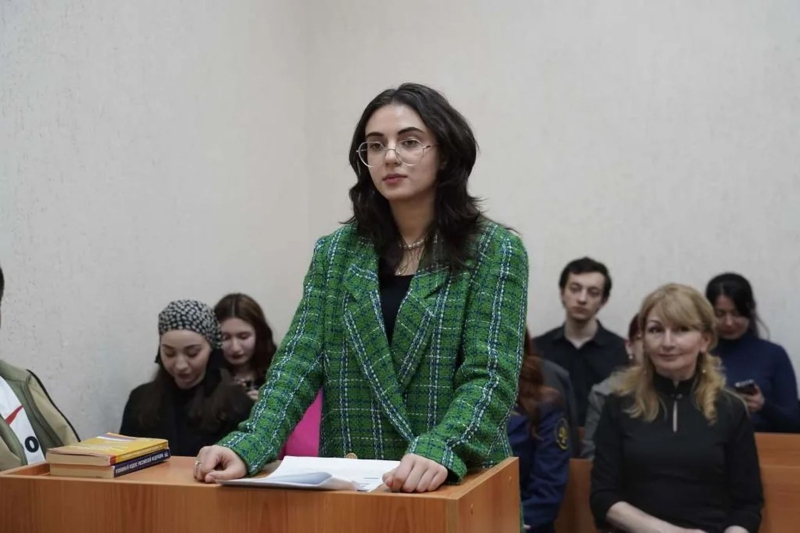
Roman Ivanov does not believe that such activities promote legal awareness: “Children only understand that the state considers certain actions punishable and that defending them is risky. It’s real intimidation, and on top of that, they are studying articles of the Criminal Code that are unconstitutional.” According to Ivanov, “mock trials” create a constant feeling among teenagers that “if they do something wrong, they will be imprisoned.”
The Ministry of Education and Science recommends holding a preventive activity called “Jeff’s Discussion.” The room is divided into three zones: “yes,” “no,” and “undecided.” The teacher asks students questions, and depending on their position, they stand in one of the sectors. The teacher’s task in this exercise is “to identify the leaders and followers of the group, learn opinions on certain topics, and detect students with radical views.”
Questionnaires have been developed for discussions on three topics: “media safety,” “spiritual and moral values,” and “civic position.” A report on such an activity at the Kaluga Cadet Multidisciplinary College states that the exercise helps students learn to defend their opinions and “better understand the world and their own group.” However, “this is not an anonymous survey, so a child may feel that if they express an opinion disapproved of by others, they will be ‘marked’ and referred to a psychologist, homeroom teacher, or other specialists,” says Roman Ivanov.
Combating “extremist and terrorist ideology” in educational institutions has effectively turned into a hunt for anyone deemed undesirable, says Dima Zitser:
“This is spy mania — the revival of informing and denunciation. There are no such things as ‘right’ or ‘wrong accounts.’ No one writes, ‘I’m a terrorist, I want to blow everyone up,’ but the interpretation of what is dangerous or destructive is far too broad.”
To identify “socially dangerous” students, in 2019 Rosmolodezh established the Center for the Study and Network Monitoring of the Youth Environment (CISM). In 2021, the organization was promised 1.6 billion rubles ($22 million at the time) to develop a system for determining schoolchildren’s propensity for “destructive behavior” based on their written assignments.
Regional branches are creating “cyber volunteer” squads to help identify “illegal” content and spread “preventive” materials, and campaigns to search for “illegal content” online are being conducted. For instance, in 2024, authorities in the Rostov region organized three such events during which “cyber volunteers” submitted 327 links to police — 198 related to terrorism and extremism, 60 to drug propaganda, and 69 to “destructive content harmful to children’s health and development.” Such campaigns were suspended after the State Duma introduced penalties in July 2025 for the “deliberate search for extremist materials” online.
Surveillance of teenagers online can be initiated by law enforcement. For example, the Ministry of Internal Affairs in Perm Krai conducts an annual campaign called “Your Choice,” which is aimed at “neutralizing attempts to involve teenagers in destructive and extremist activities.” As part of the campaign, teachers check students for participation in “destructive groups,” and any findings are “forwarded to the commissions for juvenile affairs and the protection of their rights, as well as to the regional departments of the Russian Ministry of Internal Affairs in Perm Krai and the cyber volunteer squad of Perm Krai.”
As part of the Your Choice campaign, teachers check students for participation in “destructive groups,” and any findings are reported to the commissions for juvenile affairs
The culture of informing is producing tangible results. In Severodvinsk, the principal of a gymnasium reported a student who left an anti-war note in a school bathroom. Her colleague from the city of Pyt-Yakh reported a student’s mother because the girl had blue-and-yellow braids. Alexander Skvortsov, a coach at an Irkutsk Olympic reserve sports school, was sentenced to four years in prison and added to the list of “terrorists and extremists” after a colleague reported him for taking down a Russian flag.
Elena Kolotovkina, a member of the Civic Chamber of Russia, recounted on her Telegram channel how a woman reported her son’s classmate: “The child allegedly said unpleasant things about her husband, a participant in the special military operation.” According to Kolotovkina, the school “responded immediately” and determined that “the entire family holds a traitorous position.”
Students themselves also participate in reporting. In Penza in the spring of 2022, eighth-grade girls reported their teacher, Irina Gen, for saying, “until Russia learns to behave in a civilized way, this will continue.” Gen was later sentenced to five years probation. In 2025, 66-year-old teacher Natalia Taranushenko from the Moscow region was sentenced in absentia to seven years in a penal colony for conducting an anti-war “Lesson of Kindness” for children during the first months after the invasion of Ukraine. One student reported her to his father, who then filed the report. The teacher had already left Russia, so the sentence was handed down in absentia.
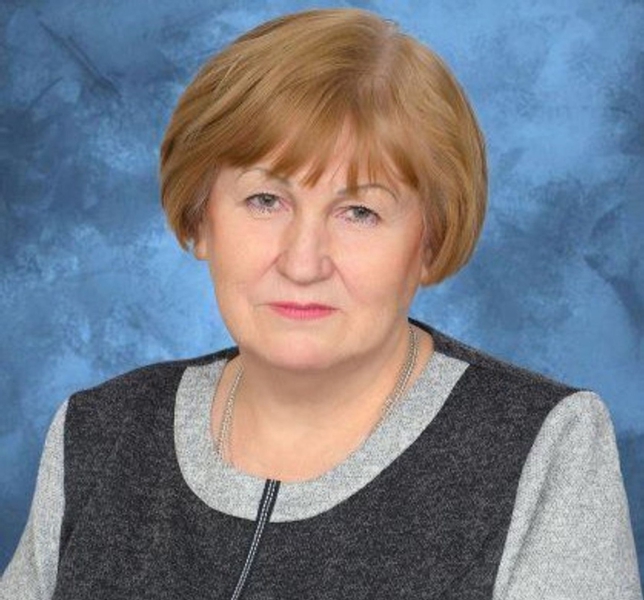
Roman Ivanov believes that it is unlikely the younger generation can be widely instilled with “spy mania,” but older individuals may have different motives for hunting “enemies”: “Teenagers today are fairly far from mass reporting. It’s another matter when these are older people, and for them, identifying ideological enemies can be a way to build a political career, curry favor with the system, gain visibility with authorities, or join a political party.”
Avoiding the implementation of the “methodological recommendations” is almost impossible for an ordinary schoolteacher, says Pavel Talankin: “If you’re required to show a film to students, you also have to publish a report on the school’s VK page. If you’re asked to make a multimedia panel, it has to be photographed and posted as well.” Talankin’s film about propaganda among children was created precisely from such assignments. Report photos can be found in the public pages of almost every educational institution — they show students posing with patriotic posters or attending lectures.
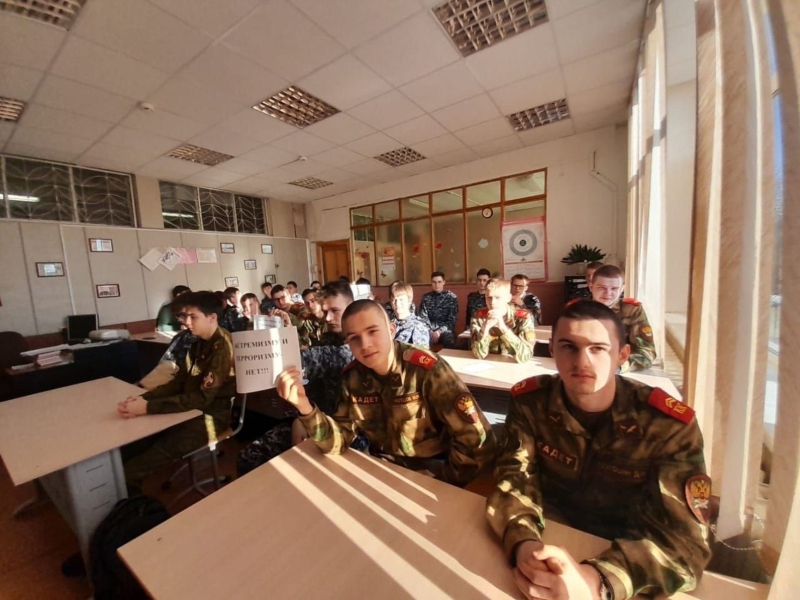
Most teachers approach the documentation of propaganda activities formally, Talankin notes: “So many of these manuals arrive that you think: let’s just get it done quickly, report it, and move on with our own work. But there are also those who take it seriously.” These teachers, however, are guided not by patriotic feelings, but by fear of punishment from above:
“We can’t refuse. Otherwise, the organization that sent them will call the administration and ask why it wasn’t done — and you’ll immediately get in trouble. Once, they called and asked why our teachers rarely post in the internal chat. We had to ask a colleague to post regularly and even greet people on holidays.”
The freedom of a teacher’s actions is determined not by the state’s guidelines but by the circumstances of each specific school, says Roman Ivanov:
“The degree of freedom depends on the overall atmosphere in the school, the students, their parents, the administration, and how willing it is to support and protect teachers. Formally, we are supposed to follow the official textbooks, but if they contain false information, I explain that this information does not correspond to the facts.”
Ivanov gives the example of the number of regions in Russia: “I indicate how many there are according to the Russian authorities and how many according to the international community.” He sees his task as teaching critical thinking but does not want to provoke conflicts within the class.
According to Ivanov, most students are not politically engaged, but LGBT topics provoke mixed reactions: “Students are curious about this themselves because much of their information comes not from textbooks but from the news and other sources. I explain the different family structures in various countries, and if I hear insults, I don’t forbid them, but I point out that it’s discrimination, and in many countries, it’s punishable by fines.” The teacher admits that LGBT topics are absent from his teaching materials, but addressing them in class is necessary:
“Yes, by doing this, I technically break the law by forming a ‘representation of the equality of such relationships,’ but as a teacher, you either teach honestly or not at all. What’s the point of teaching social studies if you constantly omit things, distort them, or lie?”
Disloyalty can result in the persecution of the entire educational institution. In Novosibirsk, a private college faced three administrative cases for refusing to conduct “Conversations about Important Things.” It was fined a largely symbolic 50,000 rubles ($600), but a year later, it was forced to close. According to OVD-Info, since the start of Russia’s full-scale invasion of Ukraine, 167 political criminal cases have been opened against teachers and students, even if administrative cases related to discrediting the army have declined over the past few years: from 124 in 2022 to 39 in 2023 and 20 in 2024.
Since the start of the war in Ukraine, 167 political criminal cases have been opened against teachers and students
Talankin argues that “prevention of destructive actions” is ineffective in principle because the authorities do not have a clear understanding of what they are supposedly fighting against, given that definitions vary from agency to agency. “The state has no idea what’s inside it. It’s a black box,” Talankin says. “It lacks the proper expertise to combat phenomena, even if it wants to.”
Dima Zitser believes that “preventive activities” in schools have little to do with countering terrorism and are closer to the Federal Penitentiary Service (FSIN) in spirit: “This isn’t prevention — it’s about prison, about manipulative tools to pin something on anyone.”
Roman Ivanov expects that mass “anti-extremism” campaigns will inevitably work against the authorities’ stated goals: “Right now this is about protecting the political regime, not citizens. There should be a balance between security and human rights, but the way Russia does this now will only breed terrorism. You remove almost every possible legal, nonviolent channel for protest, and the chances that you’ll get violence instead increase.”

